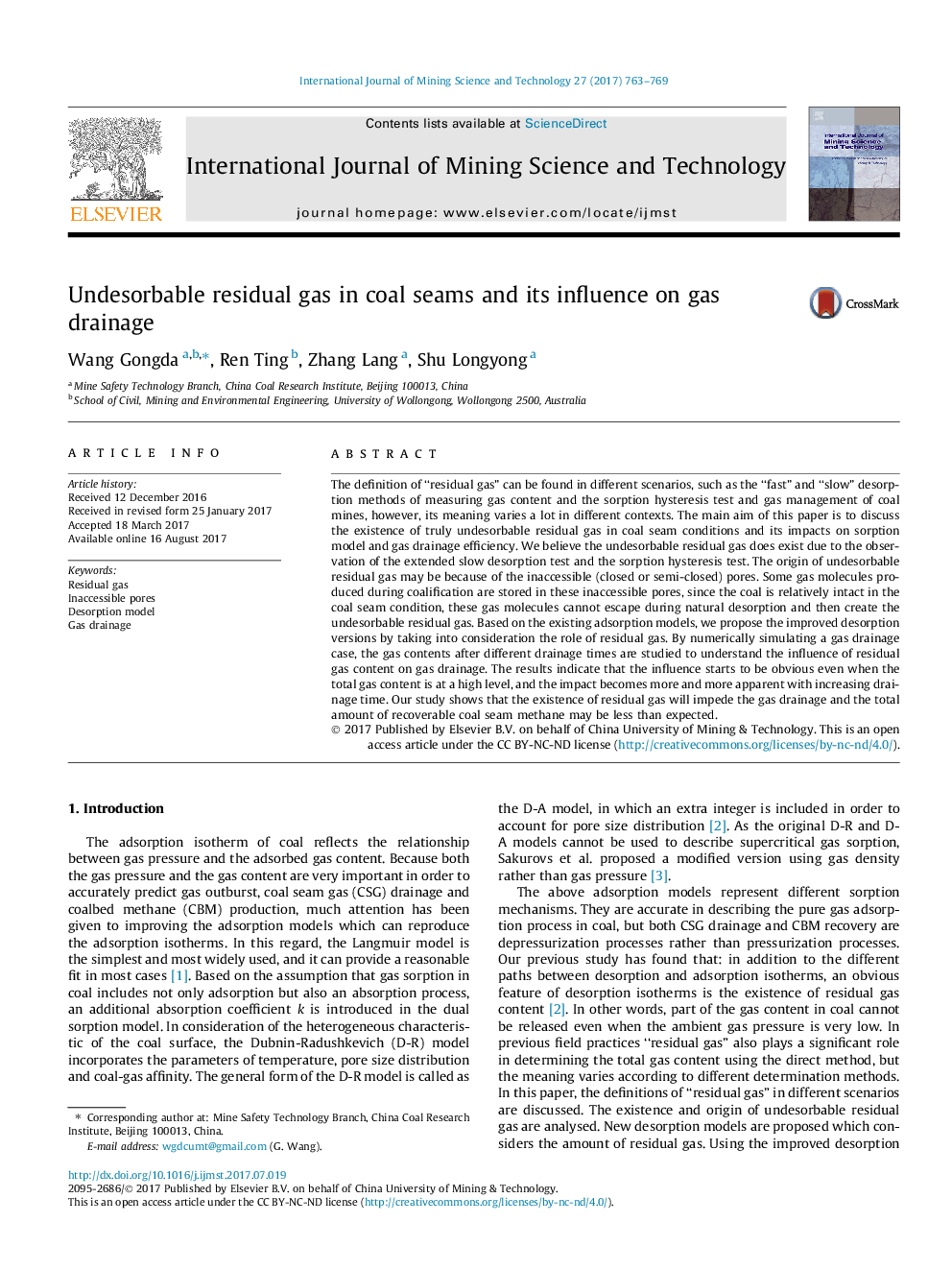| کد مقاله | کد نشریه | سال انتشار | مقاله انگلیسی | نسخه تمام متن |
|---|---|---|---|---|
| 4921740 | 1429519 | 2017 | 7 صفحه PDF | دانلود رایگان |
عنوان انگلیسی مقاله ISI
Undesorbable residual gas in coal seams and its influence on gas drainage
ترجمه فارسی عنوان
گاز باقی مانده غیر قابل جذب در جوش های زغال سنگ و تاثیر آن در زهکشی گاز
دانلود مقاله + سفارش ترجمه
دانلود مقاله ISI انگلیسی
رایگان برای ایرانیان
کلمات کلیدی
گاز باقی مانده، منافذ غیر قابل دسترس مدل تخلیه، زهکشی گاز
ترجمه چکیده
تعریف یک گازسوز باقی مانده می توان در سناریوهای مختلف مانند یک فاستا یافت؟ و یک آهسته روشهای تخلیه اندازه گیری مقدار گاز و تست هیسترزیزس جذب و مدیریت گاز معادن زغالسنگ، با این حال معنی آن در زمینه های مختلف متفاوت است. هدف اصلی این مقاله این است که در مورد وجود گاز باقیمانده غیر قابل جذب در شرایط تنش زغال سنگ و تأثیر آن بر مدل جذب و راندمان زهکشی گاز مورد بحث قرار گیرد. ما بر این باوریم که گاز باقی مانده نامناسب ممکن است به دلیل مشاهدات آزمون تمدید دشوار و آزمون هیسترزیس جذب وجود داشته باشد. منشا گاز باقی مانده غیر قابل جذب ممکن است به دلیل منافذ (بسته یا نیمه بسته) غیر قابل دسترس باشد. بعضی از مولکول های گاز تولید شده در طول زغال سنگ در این منافذ های غیر قابل دسترس نگهداری می شوند، زیرا زغال سنگ در شرایط جوش زغال سنگ نسبتا دست نخورده است، این مولکول های گاز نمی توانند در طی جذب طبیعی فرار کنند و سپس گاز باقی مانده نامنظم را ایجاد کنند. بر اساس مدل های جذب موجود، ما پیشنهاد می کنیم نسخه های بهبود یافته را با توجه به نقش گاز باقی مانده پیشنهاد کنیم. با یک بار شبیه سازی یک گاز زهکشی گاز، محتویات گاز پس از زمان های مختلف زهکشی مورد بررسی قرار می گیرد تا درک تاثیر مقدار گاز باقی مانده در زهکشی گاز. نتایج نشان می دهد که نفوذ شروع به آشکار شدن می کند حتی زمانی که مقدار کل گاز در سطح بالا قرار دارد و تاثیر آن با افزایش زمان تخلیه بیشتر می شود. مطالعه ما نشان می دهد که وجود گاز باقی مانده باعث تخریب گاز می شود و کل مقدار متان قابل جابجایی ذغال سنگ ممکن است کمتر از حد انتظار باشد.
موضوعات مرتبط
مهندسی و علوم پایه
علوم زمین و سیارات
زمین شناسی اقتصادی
چکیده انگلیسی
The definition of “residual gas” can be found in different scenarios, such as the “fast” and “slow” desorption methods of measuring gas content and the sorption hysteresis test and gas management of coal mines, however, its meaning varies a lot in different contexts. The main aim of this paper is to discuss the existence of truly undesorbable residual gas in coal seam conditions and its impacts on sorption model and gas drainage efficiency. We believe the undesorbable residual gas does exist due to the observation of the extended slow desorption test and the sorption hysteresis test. The origin of undesorbable residual gas may be because of the inaccessible (closed or semi-closed) pores. Some gas molecules produced during coalification are stored in these inaccessible pores, since the coal is relatively intact in the coal seam condition, these gas molecules cannot escape during natural desorption and then create the undesorbable residual gas. Based on the existing adsorption models, we propose the improved desorption versions by taking into consideration the role of residual gas. By numerically simulating a gas drainage case, the gas contents after different drainage times are studied to understand the influence of residual gas content on gas drainage. The results indicate that the influence starts to be obvious even when the total gas content is at a high level, and the impact becomes more and more apparent with increasing drainage time. Our study shows that the existence of residual gas will impede the gas drainage and the total amount of recoverable coal seam methane may be less than expected.
ناشر
Database: Elsevier - ScienceDirect (ساینس دایرکت)
Journal: International Journal of Mining Science and Technology - Volume 27, Issue 5, September 2017, Pages 763-769
Journal: International Journal of Mining Science and Technology - Volume 27, Issue 5, September 2017, Pages 763-769
نویسندگان
Wang Gongda, Ren Ting, Zhang Lang, Shu Longyong,
